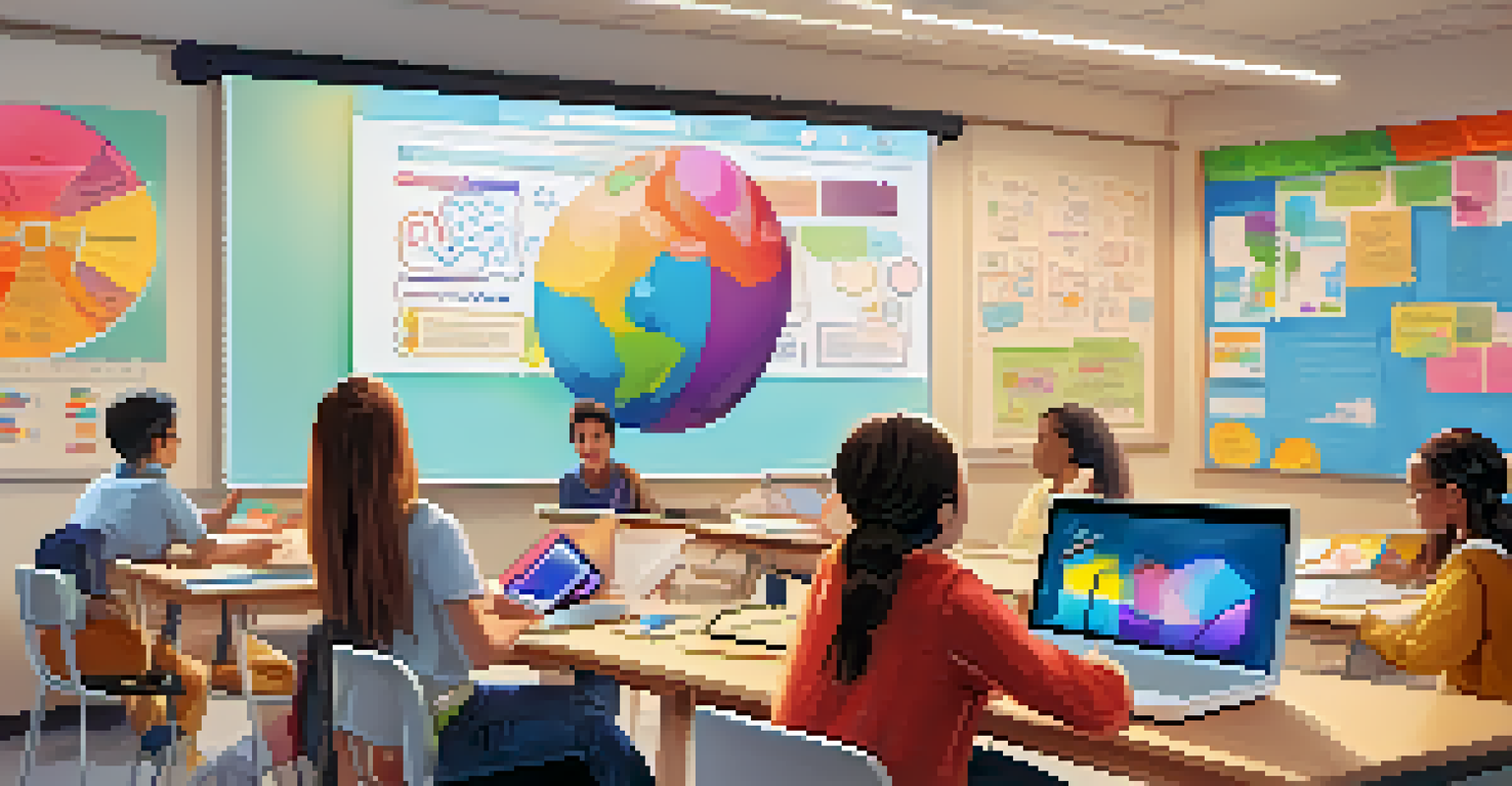Using Graphic Organizers to Enhance Online Learning

Understanding Graphic Organizers and Their Benefits
Graphic organizers are visual tools that help structure information and ideas. They can take various forms, like mind maps, flowcharts, or Venn diagrams, making complex topics easier to digest. By presenting information visually, they enhance comprehension, retention, and retrieval of knowledge, which is especially beneficial in an online learning environment.
Graphic organizers are a way of organizing thoughts visually, facilitating deeper understanding and retention.
In online learning, where students often feel isolated, graphic organizers can create a sense of connection with the material. They provide a framework that encourages learners to organize their thoughts and see relationships between concepts. This structured approach not only aids in understanding but also fosters critical thinking skills.
For instance, a mind map can help students brainstorm ideas for an essay, visually linking related concepts. This method can reduce overwhelm and stimulate creativity, making learning both engaging and effective. Ultimately, graphic organizers empower students to take charge of their learning journey.
Types of Graphic Organizers for Online Learning
There are several types of graphic organizers, each serving different purposes in the learning process. For instance, concept maps are great for showing relationships between ideas, while flowcharts can outline processes step-by-step. Choosing the right type depends on the content and the learning objective.

Another popular type is the KWL chart, which helps students outline what they Know, what they Want to know, and what they’ve Learned. This organizer not only sets a clear learning path but also encourages reflection, making it a favorite among educators. Such tools can provide a clear visual representation of students' progress.
Graphic Organizers Enhance Learning
These visual tools simplify complex information, improving comprehension and retention in online education.
Additionally, timelines can help students understand historical events or project schedules. By incorporating these diverse graphic organizers, educators can cater to various learning styles and preferences, enhancing the overall online learning experience.
Incorporating Graphic Organizers into Lesson Plans
Integrating graphic organizers into online lesson plans can significantly boost student engagement. Educators can introduce these tools at the beginning of a lesson to outline key concepts and objectives. This not only provides a roadmap for students but also helps them visualize the connection between ideas.
The more we engage students in their learning, the more they take ownership of it.
During lectures or discussions, instructors can encourage students to fill out graphic organizers in real-time. This interactive approach fosters participation and deepens understanding as students actively engage with the material. It also creates opportunities for collaborative learning, even in a virtual environment.
Finally, using graphic organizers as assessment tools can help educators gauge student understanding. Assigning students to create their own organizers based on lessons learned can reveal their grasp of the subject matter while allowing them to express their creativity.
Benefits of Graphic Organizers for Student Engagement
Graphic organizers can significantly enhance student engagement in online learning. Their visual nature appeals to learners who may struggle with traditional text-heavy materials. By breaking down information into manageable chunks, they invite students to participate actively rather than passively absorb information.
Moreover, graphic organizers encourage collaboration among students, even in a virtual setting. For instance, using shared digital platforms, students can work together on a graphic organizer, exchanging ideas and building upon each other’s thoughts. This collaborative aspect can foster a sense of community that is often lacking in online education.
Diverse Types for Various Needs
Different graphic organizers, like mind maps and KWL charts, cater to various learning styles and objectives.
As students interact with these tools, they’re likely to develop a greater sense of ownership over their learning. This empowerment can lead to increased motivation and a more positive attitude toward academic challenges, transforming their online learning experience.
Challenges of Using Graphic Organizers in Online Learning
While graphic organizers offer numerous benefits, there are challenges to consider. One common issue is that not all students are familiar with using these tools effectively. Some may require additional guidance or training to understand how to create and utilize graphic organizers to their fullest potential.
Additionally, technical difficulties can arise in an online environment. Students may face challenges using digital tools designed for graphic organization, which can hinder their learning experience. It's crucial for educators to provide support and select user-friendly platforms to minimize these frustrations.
Lastly, educators must ensure that graphic organizers are used purposefully and not just as a decorative addition to lessons. If students perceive them as busy work, the intended benefits can be lost. Thus, integrating graphic organizers thoughtfully into the curriculum is essential for maximizing their impact.
Tools and Resources for Creating Graphic Organizers
There are various digital tools available that make creating graphic organizers easy and accessible. Platforms like Canva, Lucidchart, and MindMeister offer user-friendly interfaces and templates, allowing students to customize their organizers according to their preferences. These tools can make the process not only efficient but also enjoyable.
Moreover, many educational institutions provide access to graphic organizer software as part of their online learning resources. These tools often come with built-in tutorials and support, making it easier for students to get started. The availability of such resources can enhance student confidence and competence in using graphic organizers.
Integration Boosts Student Engagement
Incorporating graphic organizers into lesson plans fosters active participation and collaboration among students.
In addition to software, educators can also find countless templates online that cater to various subjects and learning objectives. By leveraging these resources, instructors can effectively integrate graphic organizers into their lessons, ensuring that all students have the opportunity to benefit from this powerful learning tool.
Real-Life Examples of Graphic Organizers in Action
Many educators have successfully implemented graphic organizers in their online courses with impressive results. For example, a high school history teacher used timelines to help students visualize the sequence of events during World War II. This approach not only simplified the complex material but also sparked engaging discussions among classmates.
Another instance involved a university professor who utilized concept maps to help students grasp complex theories in psychology. By allowing students to create their own maps, they could visually connect various psychological concepts, leading to deeper understanding and retention. This interactive learning experience made the material more relatable.

These real-life examples illustrate the versatility of graphic organizers across different subjects and education levels. By witnessing the positive impact of these tools, educators can be inspired to incorporate them into their own online teaching practices.